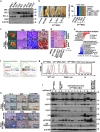Increased survival and cell cycle progression pathways are required for EWS/FLI1-induced malignant transformation
- PMID: 27735950
- PMCID: PMC5133963
- DOI: 10.1038/cddis.2016.268
Increased survival and cell cycle progression pathways are required for EWS/FLI1-induced malignant transformation
Erratum in
-
Correction: Increased survival and cell cycle progression pathways are required for EWS/FLI1-induced malignant transformation.Cell Death Dis. 2018 Jul 23;9(8):800. doi: 10.1038/s41419-018-0773-9. Cell Death Dis. 2018. PMID: 30038364 Free PMC article.
Retraction in
-
Retraction Note: Increased survival and cell cycle progression pathways are required for EWS/FLI1-induced malignant transformation.Cell Death Dis. 2019 Aug 13;10(8):605. doi: 10.1038/s41419-019-1853-1. Cell Death Dis. 2019. PMID: 31406155 Free PMC article.
Abstract
Ewing sarcoma (ES) is the second most frequent childhood bone cancer driven by the EWS/FLI1 (EF) fusion protein. Genetically defined ES models are needed to understand how EF expression changes bone precursor cell differentiation, how ES arises and through which mechanisms of inhibition it can be targeted. We used mesenchymal Prx1-directed conditional EF expression in mice to study bone development and to establish a reliable sarcoma model. EF expression arrested early chondrocyte and osteoblast differentiation due to changed signaling pathways such as hedgehog, WNT or growth factor signaling. Mesenchymal stem cells (MSCs) expressing EF showed high self-renewal capacity and maintained an undifferentiated state despite high apoptosis. Blocking apoptosis through enforced BCL2 family member expression in MSCs promoted efficient and rapid sarcoma formation when transplanted to immunocompromised mice. Mechanistically, high BCL2 family member and CDK4, but low P53 and INK4A protein expression synergized in Ewing-like sarcoma development. Functionally, knockdown of Mcl1 or Cdk4 or their combined pharmacologic inhibition resulted in growth arrest and apoptosis in both established human ES cell lines and EF-transformed mouse MSCs. Combinatorial targeting of survival and cell cycle progression pathways could counteract this aggressive childhood cancer.
Figures






References
-
- Riggi N, Suva ML, Suva D, Cironi L, Provero P, Tercier S et al. EWS-FLI-1 expression triggers a Ewing's sarcoma initiation program in primary human mesenchymal stem cells. Cancer Res 2008; 68: 2176–2185. - PubMed
Publication types
MeSH terms
Substances
Grants and funding
LinkOut - more resources
Full Text Sources
Other Literature Sources
Research Materials
Miscellaneous

